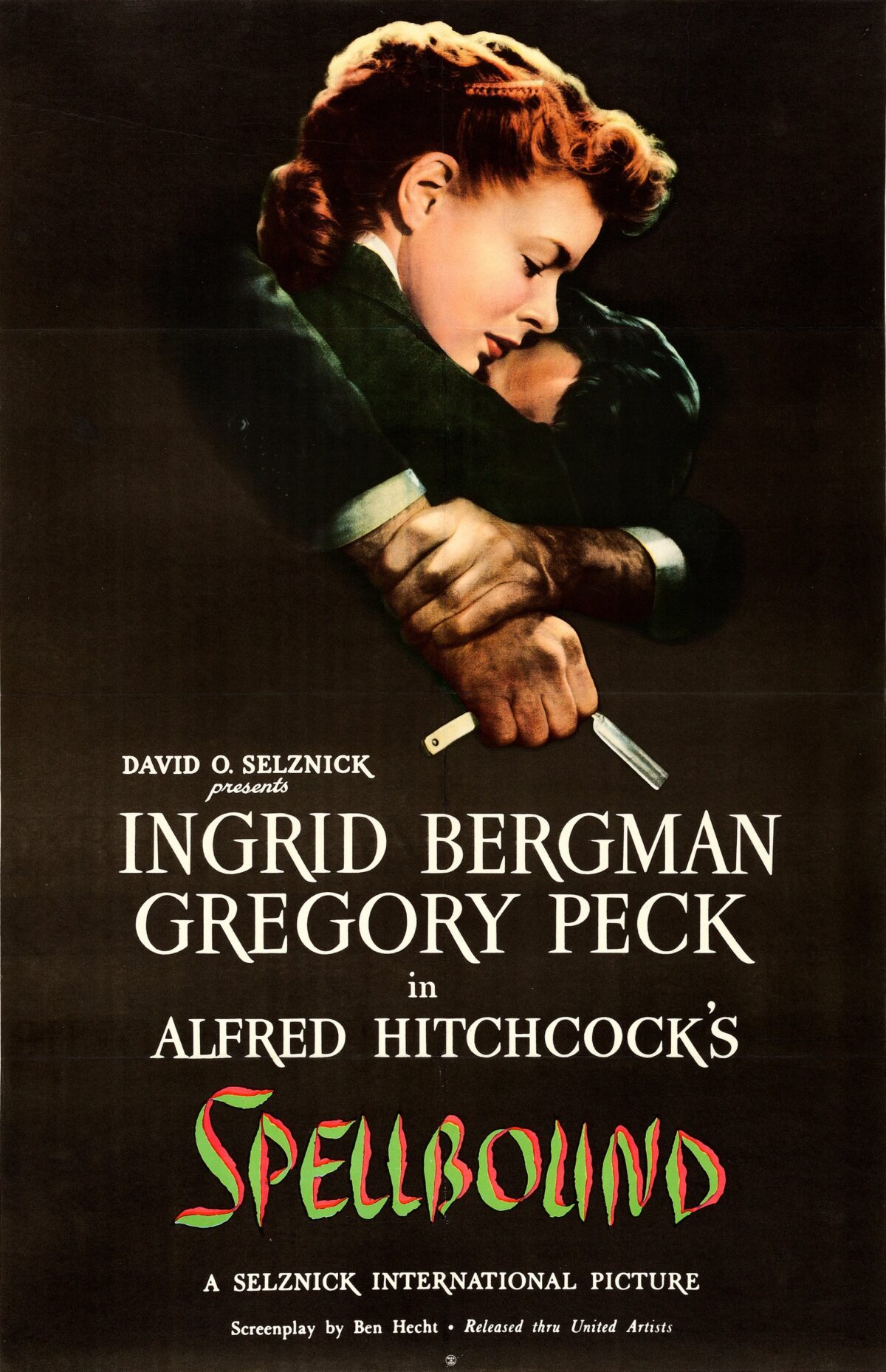Introduction:
Released in 1945, “Spellbound” is a captivating thriller directed by the legendary Alfred Hitchcock. Known for his mastery in suspense and psychological tension, Hitchcock delves into the realms of psychoanalysis and mystery, creating a film that weaves an intricate web of intrigue. In this comprehensive review, we will explore the film’s narrative complexities, the symbiotic collaboration between Hitchcock and Salvador Dalí, the stellar performances of Ingrid Bergman and Gregory Peck, and the enduring legacy of “Spellbound” as a cinematic gem within the thriller and mystery genres.
I. The Collaborative Genius: Hitchcock and Dalí
1.1 Salvador Dalí’s Surreal Contribution:
- Hitchcock’s collaboration with renowned surrealist artist Salvador Dalí for the dream sequence stands as a highlight of “Spellbound.”
- Dalí’s distinct visual style adds a layer of surrealism to the film, elevating the psychological impact of the narrative.
1.2 The Dream Sequence:
- Dalí’s surrealistic imagery takes center stage in the dream sequence, offering a visual representation of the characters’ psychological struggles.
- The dream sequence is a testament to Hitchcock’s willingness to experiment with unconventional artistic collaborations.
II. The Intricacies of Psychoanalysis:
2.1 Dr. Constance Petersen (Ingrid Bergman):
- Ingrid Bergman delivers a nuanced performance as Dr. Constance Petersen, a psychiatrist at Green Manors mental asylum.
- Dr. Petersen becomes entangled in a web of mystery and intrigue as she seeks to uncover the truth behind the new director, Dr. Anthony Edwardes.
2.2 Dr. Anthony Edwardes (Gregory Peck):
- Gregory Peck’s portrayal of Dr. Anthony Edwardes adds layers of ambiguity to the narrative.
- The character’s amnesia and the ensuing psychological investigation become the focal point of the film, exploring themes of identity and trauma.
III. Hitchcock’s Direction: A Masterclass in Suspense
3.1 Tension and Intrigue:
- Hitchcock employs his trademark techniques to build tension and suspense throughout “Spellbound.”
- From carefully crafted visual cues to deliberate pacing, Hitchcock keeps the audience on the edge of their seats as the mystery unfolds.
3.2 Symbolism and Imagery:
- Hitchcock’s use of symbolism and visual motifs enhances the psychological depth of the narrative.
- The recurring imagery of parallel lines, keys, and the color white adds layers of meaning and intrigue to the overall visual composition.
IV. The Romance Element:
4.1 Constance and Anthony: A Complex Relationship:
- The romance between Dr. Constance Petersen and Dr. Anthony Edwardes is a pivotal element that adds emotional depth to the film.
- Hitchcock explores the complexities of love and trust against the backdrop of a psychological mystery.
4.2 Ingrid Bergman’s Captivating Presence:
- Ingrid Bergman’s on-screen chemistry with Gregory Peck contributes to the film’s emotional resonance.
- Bergman’s performance captures the strength and vulnerability of her character, making Dr. Petersen a compelling and relatable protagonist.
V. The Musical Score: Miklós Rózsa’s Enchanting Composition
5.1 Atmospheric Soundtrack:
- Composer Miklós Rózsa’s musical score for “Spellbound” enhances the film’s atmosphere and heightens its emotional impact.
- The haunting melodies and sweeping orchestration complement the psychological tension, creating a symphony of suspense.
5.2 Academy Award Recognition:
- Rózsa’s exceptional work in “Spellbound” earned him the Academy Award for Best Original Score, further solidifying the film’s impact on both visual and auditory storytelling.
VI. Reception and Critical Acclaim:
6.1 Box Office Success:
- “Spellbound” was a commercial success upon its release, resonating with audiences eager for a Hitchcockian blend of mystery and romance.
- The film’s box office success paved the way for its enduring legacy in the annals of cinematic history.
6.2 Academy Award Recognition:
- In addition to Miklós Rózsa’s win for Best Original Score, “Spellbound” received several Academy Award nominations, including Best Picture and Best Director for Alfred Hitchcock.
- The film’s critical acclaim solidified Hitchcock’s reputation as a master of suspense and psychological storytelling.
VII. Psychoanalysis in Popular Culture:
7.1 Impact on Psychology:
- “Spellbound” sparked interest in psychoanalysis and mental health, bringing these topics to the forefront of popular culture.
- The film’s exploration of Freudian concepts and its portrayal of psychiatric practices influenced how mental health was depicted in subsequent films.
7.2 Enduring Legacy:
- “Spellbound” remains a cultural touchstone, influencing subsequent psychological thrillers and leaving an indelible mark on the intersection of romance and mystery in cinema.
- Its exploration of the human psyche and the use of surreal elements continue to inspire filmmakers and storytellers.
VIII. Conclusion: A Timeless Enchantment
In conclusion, “Spellbound” is a timeless enchantment that showcases Alfred Hitchcock’s ability to craft a mesmerizing blend of mystery, romance, and psychological intrigue. The film’s daring collaboration with Salvador Dalí, coupled with the stellar performances of Ingrid Bergman and Gregory Peck, creates a cinematic experience that transcends its era. Hitchcock’s direction, the atmospheric musical score, and the enduring legacy of “Spellbound” attest to its status as a masterpiece within the thriller and mystery genres. As we revisit this captivating journey into the human mind, we are reminded of Hitchcock’s unparalleled ability to cast a spell on audiences, inviting them to explore the depths of the psyche in a cinematic tapestry woven with suspense, romance, and psychological complexity.
